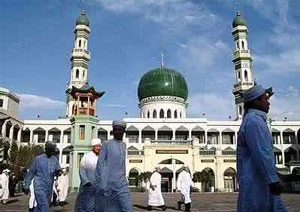Qinghai Lake, "a blue sea" in Mongolian and Tibetan, is the largest inland salt lake in China with an area of 4,500sq.km and an altitude of 3,195m , after which Qinghai Province was named. It is fascinating in its vast expanse of misty and wavy blue water. Around the lake is the endless outstretching of grassland and rapes, wheat fields. In the distance, countless sheep, cattle and horses are grazing under the white cloud-dotted blue sky. Still farther away tower the snow-capped mountains.
Qinghai Lake is a beautiful inland alpine lake in Northwest China. Over the centuries, its splendid scenery and rich aquatic resources have attracted millions of tourists and numerous valiant pioneers who admire it for its vastness, splendor and mysteriousness, landing it as a sparkling diamond set in the Qinghai Plateau.
Ta'er Monastery is one of the largest monasteries of the Yellow Sect of Tibetan Buddhism and is said to be the birthplace of Zongkaba (1357-1419), the founder of the Yellow Sect.
Standing in an imposing manner according to the gradient of the mountain, the Ta'er Lamasery is a wonderful architectural complex that embraces 9,300 structures, including scripture halls, Buddha halls, lamas' residences, and Buddhist pagodas. Built in 1622, in the center of the entire complex, the Great Hall of Gold Tiles is the core structure of the lamasery. The ridges of the hall's roof are decorated with auspicious objects such as treasure bottles, gold streamers, and gold deer.
 The Great Mosque of Xining is one the four largest mosques in northwest China and is the largest and most important mosque in the Qinghai Province. Locally, it is known as the East Gate Mosque, due to its eastern location in the city alongside the Muslim Hui neighborhood. According to an inscription added to the mosque during a major reconstruction in 1914, the mosque was first built during the Ming Dynasty under Emperor Hongwu (1368-98). However, it is known that the mosque was destroyed and rebuilt entirely as recently as in the late nineteenth century. Renovated in 1914, the mosque was enlarged in 1946.
The Great Mosque of Xining is one the four largest mosques in northwest China and is the largest and most important mosque in the Qinghai Province. Locally, it is known as the East Gate Mosque, due to its eastern location in the city alongside the Muslim Hui neighborhood. According to an inscription added to the mosque during a major reconstruction in 1914, the mosque was first built during the Ming Dynasty under Emperor Hongwu (1368-98). However, it is known that the mosque was destroyed and rebuilt entirely as recently as in the late nineteenth century. Renovated in 1914, the mosque was enlarged in 1946.

